Peckish Pileated Woodpeckers - and why snags are so significant
Plus New Product Catalogue Available Next Week
Hello dear readers,
In just one week, on Thurs. August 8th, 2024, my new photo product catalogue goes live. I’m excited to share my new products with you, and think my new catalogue is a lovely creation in and of itself! Be sure not to miss the calendar pre-order deadline on September 12th. The monthly images in my calendars become the inspiration and subject of most of my monthly newsletters, so you can learn all about the nature and animals featured in them. Full product and ordering details will be included in the catalogue next week. Be sure to check your inbox next Thursday. (Sales in Canada only at this time).
Peckish Pileated Woodpeckers
There’s a woosh of wings, and I look up from my chair on the deck of my friends’ house to see a Pileated woodpecker, with its characteristic red, punk rock ‘hair do,’ clinging to the trunk of a Douglas fir tree (below). He pauses there to skillfully wield his sword of a beak, gently and deftly preen his back and neck feathers.
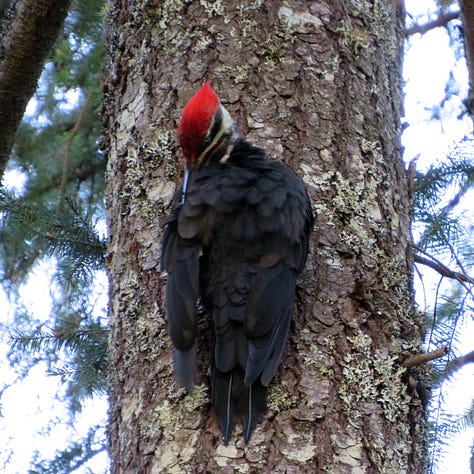
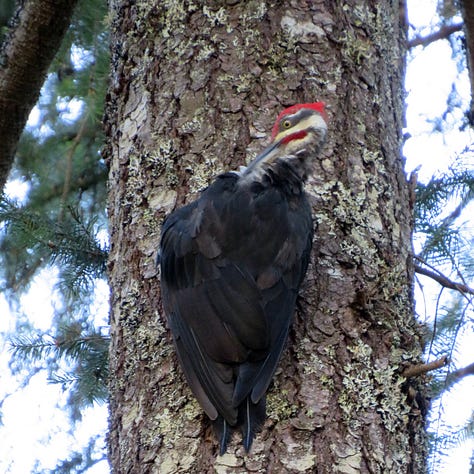
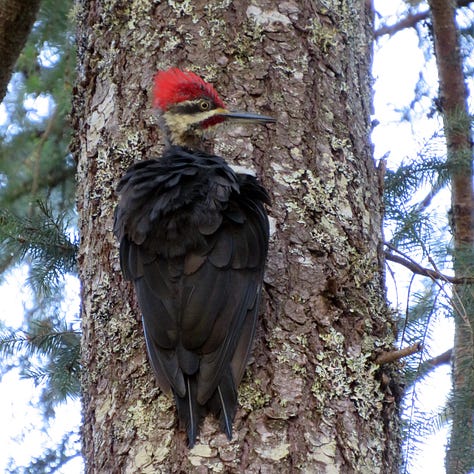
Feathers now smoothed out, he hops further up the trunk to peer out between the branches (top photo). He is an image of sleek, strong beauty. His brilliant yellow eye - which makes these birds look perpetually startled at the best of times - is intense and focused and he could disappear through the gap in the tree branches, like its a portal into another world, at any moment.
I am always in awe when I see theses large birds. At my home, I don’t see them very often at all. Yet, at my friends’, who lives in the same area, I see or hear them just about every time that I visit. One of the main difference is that their place has lots of snags close to their house. Snags are dead trees which are a real draw for woodpeckers and other wildlife. The rotting wood can contain lots of yummy insects, and it is softer to excavate for both food and cavity nests. “Where woodpeckers live, the abundance of cavities increases each year, and, more than 40 other North American bird species—not including the woodpeckers themselves—exploit this abundance for their own nests” (BVAS News). Thus, woodpeckers and snags play a huge role on the ecosystem level.
On this particular day at my friends’, I watched the Pileated woodpecker then fly over to one of these snags (above), revisiting a characteristic rectangular hole he or another Pileated had already established. As he pecked away, I could see small black flecks - carpenter ants I believe - scurrying out of the hole. He paused eat - licking some up, and grabbing others in the tip of his beak to then swallow - clearing enjoying his meal.
More recently, I was walking along the road and heard a pounding just above my head. It was a female Pileated (she doesn’t have a red ‘mustache’ like the above male) hammering away on a cedar tree, licking up ants as well. The force of her impact is apparent and astounding! If people banged out heads that hard, we’d get severe concussions. Scientists had believed the woodpeckers had tissue in the head that absorbed the impact, yet a new study concludes “[t]he birds actually minimize the need for shock absorption. How? Their heads and beaks essentially act like a stiff hammer, striking and stopping in unison” (McKee, J).
While snags play such an important ecosystem roll, most people removed dead and dying trees and shrubs from their yards. They can look “ugly” or an “eye-sore” in an otherwise green landscape. They seemingly have no more use to us, and sometimes there is a risk of them falling and causing injury so they get the axe. Yet, it is important that we all learn to look past our narrow, human-centric definitions of beauty and value, because these ‘dead’ trees contain the lives of insects and potential nesting places for a variety of birds and small mammals.
One of the ornamental cherry trees at my home died last summer and my impulse is to want to have it removed. It used to be so beautiful and it hurts to see its dead bare branches instead of its usual leaves and blossoms. But, while some branches may be removed, the rest will remain standing and it will bring food and shelter to others creatures in the coming years. I’d certainly love to see the Pileated woodpeckers here more often, with their loud laughing calls and such personality in their faces. They may seem like the hardheaded ones, but we still have a lot of learn about sharing our green space with other species.
References:
BVAS News. August 30, 2016. Woodpeckers, Cavities, and Snags: Changing a Stubborn Paradigm. Accessed April 23, 2024 at https://bvaudubon.org/2016/08/30/woodpeckers-cavities-snags-changing-stubborn-paradigm/
McKee, Jenny. July 14, 2022. New Study Shakes Up Long-held Belief on Woodpecker Hammering. Accessed April 23, 2024 at https://www.audubon.org/news/new-study-shakes-long-held-belief-woodpecker-hammering
In a couple of weeks I’m pleased to be introducing you to a special cat that I trained to do a fun trick (yes, cats can be trained!). Plus, in next month’s nature installment, we’ll take a look at a gorgeous bird species that, rather unexpectedly for one with webbed feet, does sometimes use Pileated woodpecker holes for nesting. I hope you will join me then.
Blessings to you,
Lindsay


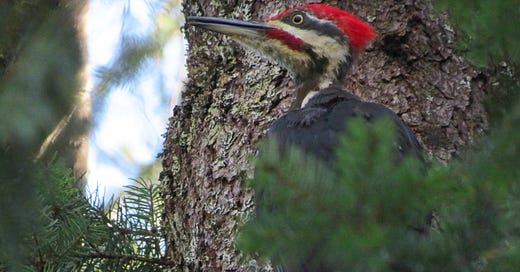




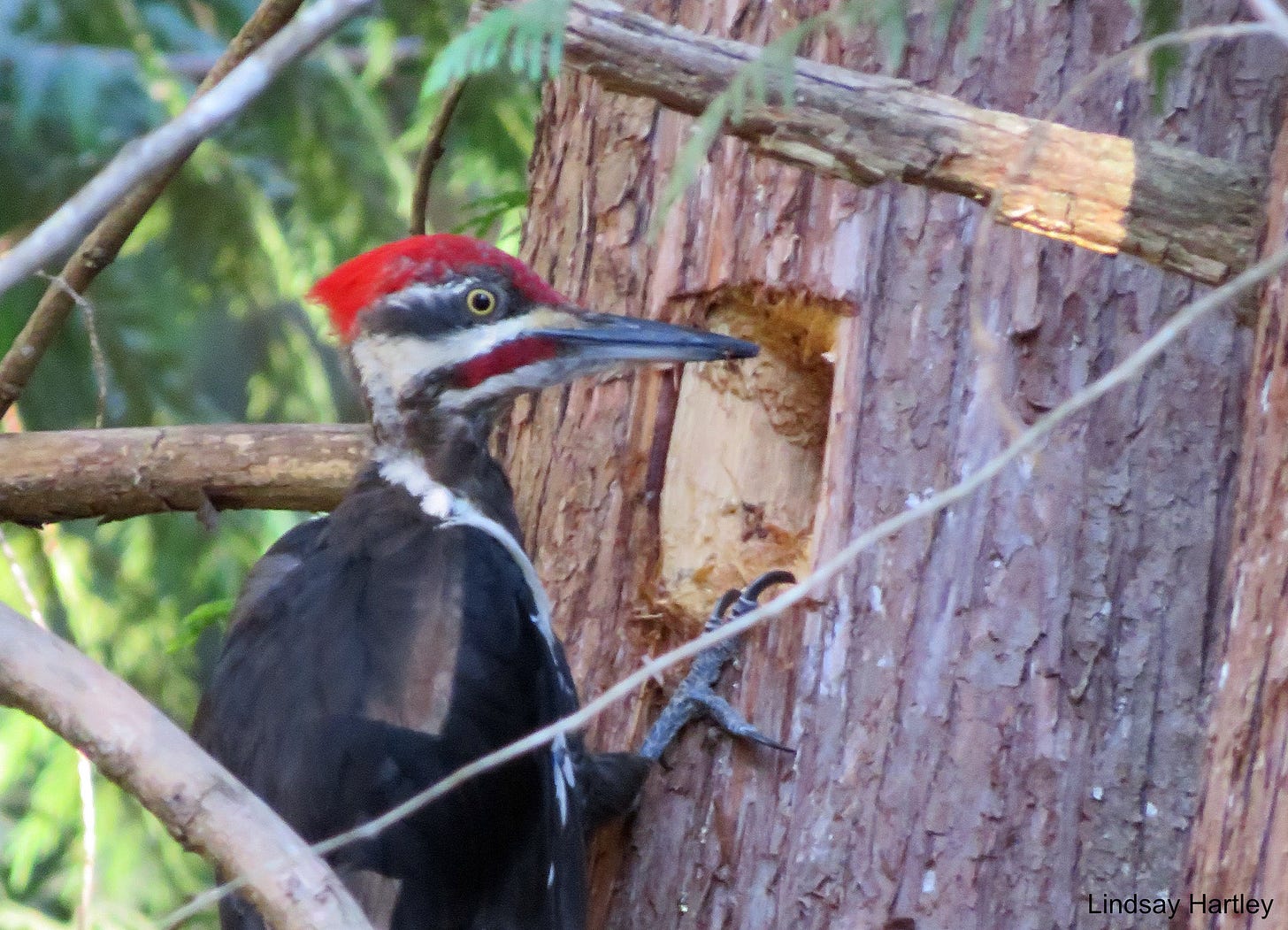

If it's made safe, dead wood is such an important habitat. Your photos are great, the Pileated seems like a particularly impressive woodpecker.